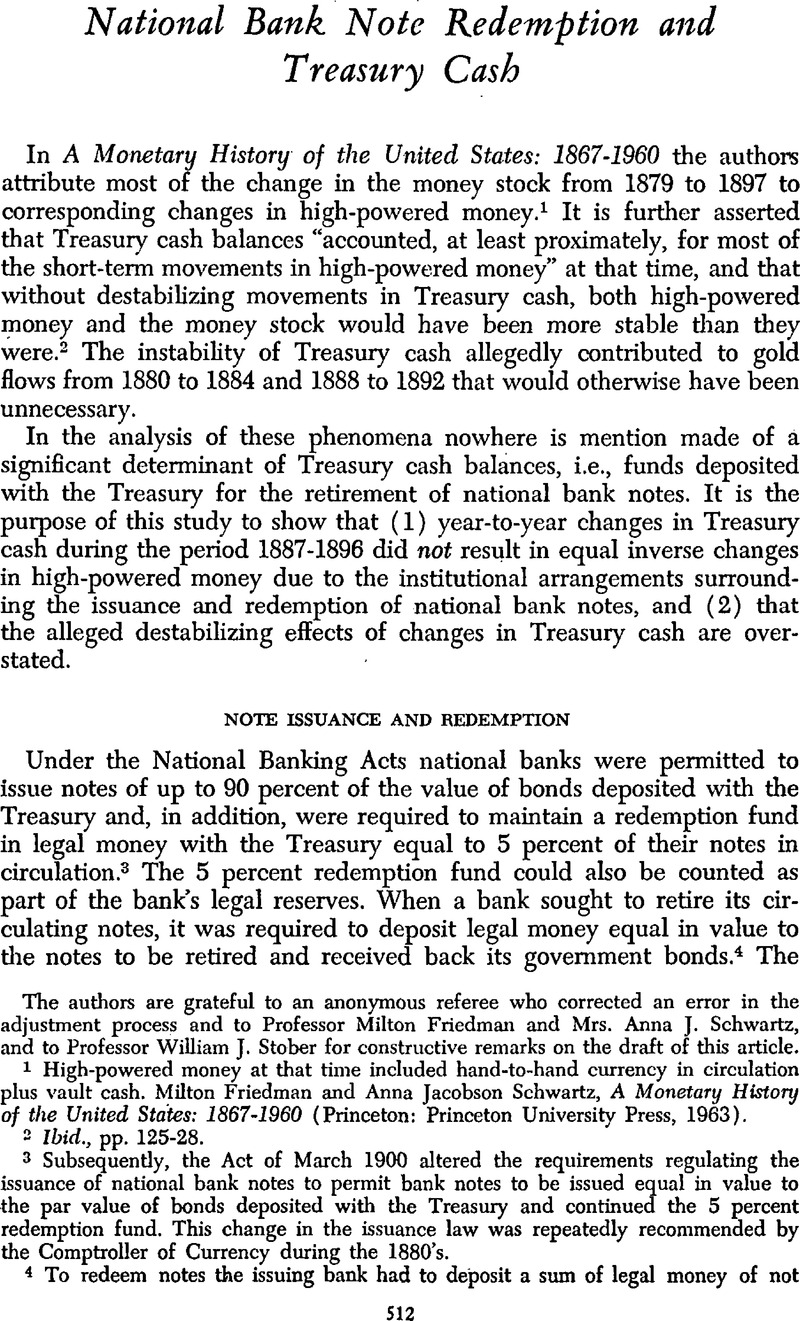Article contents
National Bank Note Redemption and Treasury Cash
Published online by Cambridge University Press: 03 February 2011
Abstract

- Type
- Notes
- Information
- Copyright
- Copyright © The Economic History Association 1969
References
The authors are grateful to an anonymous referee who corrected an error in the adjustment process and to Professor Milton Friedman and Mrs. Anna J. Schwartz, and to Professor William J. Stober for constructive remarks on the draft of this article.
1 High-powered money at that time included hand-to-hand currency in circulation plus vault cash. Friedman, Milton and Schwartz, Anna Jacobson, A Monetary History of the United States: 1867–1960 (Princeton: Princeton University Press, 1963).Google Scholar
2 Ibid., pp. 125–28.
3 Subsequently, the Act of March 1900 altered the requirements regulating the issuance of national bank notes to permit bank notes to be issued equal in value to the par value of bonds deposited with the Treasury and continued the 5 percent redemption fund. This change in the issuance law was repeatedly recommended by the Comptroller of Currency during the 1880's.
4 To redeem notes the issuing bank had to deposit a sum of legal money of not less than $9000, In addition, after the Act of July 12, 1882, a bank retiring its notes from circulation could not increase its circulation for a period of six months. Banks were also restricted to a maximum redemption deposit of $3,000,000 in any one month with the exception of redemption of notes resulting from the call of bonds by the Treasury.
5 F. W. Taussig, The Silver Situation in the United States (New York: G. P. Putnam's Sons, 1893), pp. 39–40.
6 Ibid., pp. 29–30.
7 For a discussion of the cost of national bank note issuance and profits on these issues, see Cagan, Phillip, Determinants and Effects of Changes in the Stock of Money 1875–1960 (New York: Columbia University Press, 1965), pp. 86–93Google Scholar; and Goodhart, C. A. E., “Profits on National Bank Notes, 1900–1913,” Journal of Political Economy, LXXIII (Oct., 1965), 516–22.CrossRefGoogle Scholar Note that both of these studies fail to mention that expectations about falling bond prices may have encouraged national bank note redemption and discouraged the substitution of noncallable bonds.
8 Annual Report of the Secretary of the Treasury, 1883, p. 45.
9 Report of the Comptroller of Currency, 1883, p. 10.
10 For a description of the various Acts mentioned in this study, including the Funding Act of March 1881, see Dunbar, Charles F., Currency, Finance and Banking Laws of the United States (rev. ed.; Boston: Ginn & Company, 1897), pp. 296–300.Google Scholar
11 The reader is reminded that changes in Treasury cash did not have an equal inverse effect on high-powered money due to the fact that doomed notes were destroyed when received by the Treasury. Changes in Treasury cash need to be adjusted for gross national bank note redemptions which represent decreases in Treasury cash not leading to changes in high-powered money outstanding.
12 These remarks are taken from Professor Friedman's and Mrs. Schwartz's “comment” on the draft of this article. These “comments” were forwarded to us by the Editor of this Journal.
13 Ibid., p. 3.
14 Friedman and Schwartz, Monetary History, pp. 125–27. Friedman and Schwartz omit the final years, “which were dominated by the silver problem.”
- 6
- Cited by


